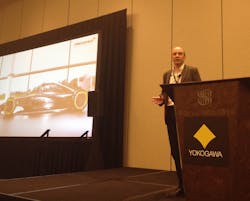At first glance, Formula 1 racing might not seem to have a whole lot to do with your typical process plant. But you might want to take a look under the hood to compare the situation with how your control room operators are reacting to the data available to them in high-stress situations.
Everywhere we look, data is becoming more important. This is true in the plant, and this is true in racing. “Data underpins everything we do in Formula 1,” said Mike Phillips, head of simulation systems at McLaren Applied Technologies.
McLaren Automotive’s high-performance vehicles are behind the most winning team in Formula 1 racing. And the modeling and simulation tools behind those cars and drivers also support McLaren Applied Technologies’ analysis for other industries like healthcare and energy.
As a keynote speaker at the Yokogawa Users Conference this week in Houston, Phillips described the kind of work his company is doing to simulate a variety of driving situations—changing variables in the cars and in the environment to see how the driver will or can best react to those changes.
A typical McLaren racecar is covered in some 120 sensors, streaming information back wirelessly to help the team discover a great deal of information about the car, Phillips described. They use the data not only to help the driver perform better, but also to help design and optimize the systems.
“Simulation is very important to us,” Phillips said. “We don’t have the time to design, make and test every single component in a racecar.”
Simulation can change performance parameters that they couldn’t change so easily in reality. Then they can put the driver into those simulations and see how he reacts to changes.
“We also simulate the performance of that car in its environment,” Phillips said. “We need to know how that performs around the circuit. We feed the data into circuit models. We can see the performance in the intended environment.”
And the results are there. Since McLaren joined the Formula 1 circuit in 1966, no other team has scored more than its 182 victories. They get those results not only from drivers that are at the peak of physical and mental health, but through data management and visualization through simulation, design, pre- and post-race analysis, and live monitoring and strategy.
And the same way McLaren can help its drivers make important decisions within 6 seconds of an unexpected event, its tools can help manage complex systems such as optimizing air traffic control at Heathrow Airport or providing decision support for offshore oil drilling.
Looking at the sorts of things McLaren is doing as it places its drivers into different system, environmental and situational parameters, it’s not difficult to see how this could apply to control room operators as well. They can test track and car conditions in a safe environment, optimizing conditions not only to win races but also to survive races. Certainly, this kind of simulation would be useful not only for training operators, but for gaining a better understanding of, in Phillips’ words, “the fleshy, irrational being that sits in the middle of that,” whether “that” is a high-speed car or a complex process facility.
Humans are the significant wildcards in any operation, especially as the technology improves. Taking their simulation capabilities even further, McLaren began working with Pfizer about seven years ago on bio-telemetry systems that analyze data to anticipate and adapt in real time.
McLaren has also been using three-axis motion technologies to try to monitor people remotely. Without video or audio, they can use a matrix to work out pretty nearly what somebody is doing at any given time.
These sensors, placed on the back of somebody’s neck, can be used to monitor workers in dangerous situations, for example, seeing if their actions might put them or other workers in greater danger. Sensors can also be used to look at workload and stress in relation to a worker’s environment.
That said, I have a hard time imagining operators being too happy about wearing monitors on the back of their necks to track their moves. Asked whether operators give them any pushback, Phillips acknowledged that they’re wary at first, but get onboard when they understand that the information is used in an aggregated sense rather than individually. However, asked whether they monitor those Formula 1 racecar drivers, he responded, “For one, drivers don’t like it.”
They do monitor drivers, however, in a simulated environment. “The trouble with simulated environments, you can’t recreate the stress you’re feeling,” Phillips said. “It’s quite immersive, but you know you’re in an office building. So the stress levels are very different. Therefore, the reactions are different.” Certainly, there are similar concerns about training operators on simulated process environments, where they are not under the same kind of stresses as in real-world situations.
Nonetheless, Formula 1 racing has proved to be a great test bed for using data, modeling and simulation to better understand situational awareness in any sort of mission-critical environment. Much the same way that technologies have been developed through space and defense industries, racing can provide the necessary funding to make improvements, Phillips said. “The fact that there’s engineering and technology behind that is kind of tertiary. People forget that,” he said.
But it’s more than just the money factor. “The pace of development is faster than what you see in any other industry,” Phillips said, noting races occurring sometimes every week, boosting the speed and accuracy of development. “What you’ve done as an engineer is tested very, very quickly. Also very, very publicly. It’s a real great test bed.”
About the Author
Aaron Hand
Editor-in-Chief, ProFood World

Leaders relevant to this article:
